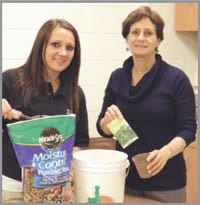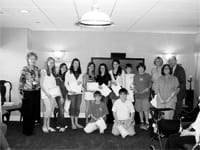Getting a New Lease on Life STCC Clinic Helps Clients Gain Measures of Independence
Norman Bail is in many ways typical of the clients who find their way to the Campus Rehabilitation Center at Springfield Technical Community College.
After a stroke in 2010 left the now-75-year-old paralyzed on the left side, he spent about a month in an inpatient rehabilitation facility, then received outpatient treatment. But before he knew it, his Medicare benefits had run out.
But he still had much work to do on his road to recovery, so he was referred to the rehab center at STCC, which offers free assessments and then physical- and occupational-therapy services to people who don’t have insurance or who have exhausted their benefits.
“Our mission is to serve people who have stopped receiving benefits through their insurance or who have insurance that doesn’t cover these services,” said Marianne Joyce, program director for the college’s Occupational Therapy Assistant Program. “Once people plateau and stop making progress, their insurance often stops covering additional treatments.”
Since beginning his course of treatment at the center, Bail has steadily gained more independence, like most other center clients. Today, he can drive a car and walk with a cane, and he no longer needs an adaptive device to use the directional signal in his vehicle. What’s more, he is making continual progress in re-mastering the drums, which he played professionally for many years.
“It has taken a long time and a lot of work,” he said of the struggle to regain the dexterity needed to play the instrument properly, “but I have made quite a bit of progress.”
There have been many similar stories of determination and overcoming adversity written with the assistance of the rehab center, its staff, and student assistants, who together have created what Joyce called a “win-win-win” situation for those students, faculty advisors, and especially clients.
Elaborating, she said that students gain invaluable hands-on experience needed to pursue careers in physical or occupational therapy, as well as confidence and a sense of confirmation that they have chosen the right career path. Meanwhile, faculty members get to work with both the students and clients to script those inspirational stories like Bail’s.
And the clients, who range from elderly stroke victims to children unable to write due to juvenile arthritis, get an opportunity to continue treatment and gain new measures of independence and self-worth.
“Their evaluation was the most thorough one I received, and they have been very helpful in many ways,” said Bail. “The students have been wonderful, and I am very grateful for all they have done.”
For this issue, HCN takes an in-depth look inside the center and examines how it operates — and changes lives.
Holistic Approach
As she talked about the center, which began operations in 2000, as well as its goals and methods for achieving them, Joyce said it takes what she called “an integrated approach to care” for clients of all ages and with many health problems — very often the victims of stroke.
Elaborating, she said this means attention to physical, mental, and emotional aspects of care for the client and, in many cases, providing different kinds of support to loved ones caring for those individuals.
“After someone has had a stroke, he or she is not the same person they used to be; they may not be able to do things they did before and may become more dependent,” Joyce said. “We assess their hobbies and interests to find things that will motivate them, and then use them in treatment. In addition, we often send their spouse for a massage.”
She gave an example of this integrated, or holistic, approach.
“We had a client who was suffering from deep depression after a stroke,” she explained. “He wanted his wife to do everything — dress him, shave his face, and make his meals, even though he had learned how to do these things in the hospital. The STCC team discovered his past interests, including a passion for building birdhouses, so they had him build one at the clinic.
“He was using motor skills as he sanded and stained the birdhouse, and the sequence of steps he took to build it involved cognitive skills,” Joyce continued. “When he finished, he felt very proud of the project, and it helped to lift his depression. We also worked with his wife to help her set boundaries and take better care of herself.”
In addition, the couple was referred to a support group for stroke victims and their families at Springfield College.
Physical therapy is also an integral part of the program, said Joyce, noting that PT tackles mobility problems caused by orthopedic or neurological conditions. To do so, the center addresses muscle strength and range of motion, which can be related to pain.
Causes range from fibromyalgia to arthritis to a stroke, which can leave one side of the body weak and/or cause pain. “Physical therapists can evaluate clients with mobility issues to see if they can benefit from a cane, walker, or wheelchair,” Joyce said.
Physical endurance is another area where people often need to make gains. “If someone was paralyzed as the result of a stroke and is just starting to walk again, a physical therapist can help get the person upright and moving and build their tolerance so they can engage in activities,” Joyce explained, adding that occupational and physical therapists work together to achieve goals.
For example, a physical therapist might help someone get to the shower, while an occupational therapist would show them how to shower using one hand. “We employ a collaborative effort to get people as independent as possible while maintaining their safety,” she said.
Student Interaction
And while the center helps clients regain large measures of independence, it also enables STCC students to gain critical hands-on experience for careers in OT and PT.
Indeed, Kinga Koziol, 21, told HCN she is grateful for the opportunities the clinic offers. “It’s very beneficial for the patients and for the students,” she explained. “We don’t have to worry about clients judging us because they know we are learning. Plus, the clinic gives people an opportunity to get care without having to worry about their finances if their insurance has run out.”
Koziol is in the Occupational Therapy Assistant program, and although she has done observation work in the field, the experience she gains at the clinic has helped her apply what she’s seen, read, and heard to actual cases. Meanwhile, she said the experience has helped reinforce her decision to pursue a career in the profession.
Students play a key role in the delivery of services at the clinic, a process that begins with a full assessment completed by a registered therapist while a student observes. Next, a treatment plan is formulated by faculty members, who discuss the client’s needs.
“After a course of action is determined, we stay with the students to make sure everything that has been prescribed is being done correctly; this is a faculty-student run teaching clinic and treatment program,” Joyce stressed, adding that everything is done under supervision.
The clinic’s mission is to help clients reach their optimal level of independence.
“In today’s health care environment, people often run out of insurance before they reach their potential, so there is a need for them to receive more services, as well as a need to educate students and have them plan and implement occupational- and physical-therapy services in an environment that is not regulated by insurance,” Joyce explained. “It’s a win-win-win situation for students, faculty members, and clients. The students can learn something in the morning, then have the opportunity to put a treatment strategy into action, so we can reinforce whatever we are teaching that day or week.”
Clients are also referred to area agencies if there are other services which can help them.
The opportunity to continue treatment after insurance has run out is important. “We have seen people make changes two years after a stroke,” Joyce said. In some instances, they have become deconditioned and don’t realize they qualify again for insurance benefits, which can be determined by the assessment.
But continued care is necessary for advances to be made. “Everyone is individual in terms of their recovery,” said Joyce. “Changes may continue, and even though they are small, the people who come here feel supported because they know someone believes in them. It gives them hope to continue to work on their recovery.”
Gains such as the ability to grasp and hold something are pivotal to independence. Therapy often includes exercises such as sweeping, as the occupational therapy suite contains a kitchen, bedroom, office space, and bathroom.
Goals can be personal, and one woman simply wanted to be able to get into the bathtub again, as she found taking baths relaxing. “We worked until she was able to do it safely,” Joyce said. “Some people only need occupational or physical therapy, while others need both.”
Helping Hands
Since the training program is for OT and PT assistants, working under the direction of staff members mirrors what graduates will encounter in the workplace after graduation.
Still, many expand their education by engaging in community-outreach volunteerism. Some work in conjunction with students from American International College, helping with a therapeutic horseback-riding program for children with disabilities held at Jericho in Holyoke, while others volunteer at a wheelchair-soccer program run by the Center for Human Development, or put their skills to work in an adapative karate program at the Jewish Community Center in Springfield.
“Every semester, we also have students who help with adaptive-dance programs in the community,” Joyce said. “Our rehabilitation campus is multi-faceted, has many aspects, and benefits many people.”
And the center, as she said, represents a classic win-win-win scenario.


